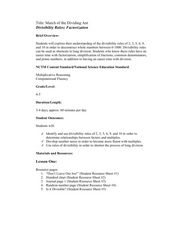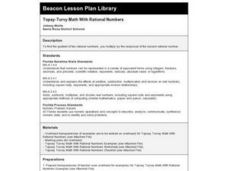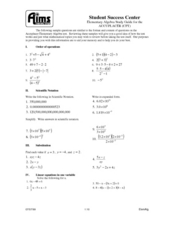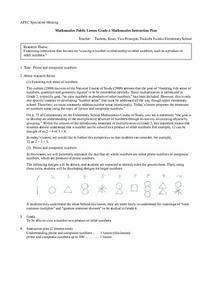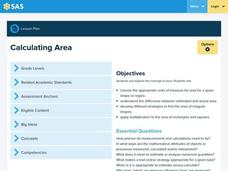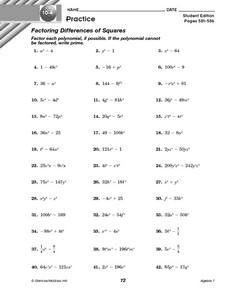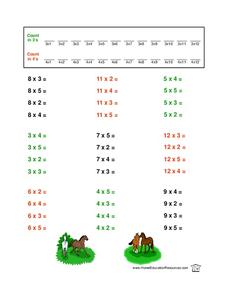EngageNY
Does Every Complex Number Have a Square Root?
Help the class find a better way. Pupils recall finding nth roots or a complex number in polar form from a previous module to find the square root of a complex number. Using the second installment in a series of 23, scholars discover it...
Curated OER
Unit Plan On Quadratic Equations
Young scholars explore a variety of ways of solving quadratic equations. Students choose from graphing, factoring, finding square roots, completing the square and using the Quadratic formula. They ponder in the end on polynomial equations.
Curated OER
March of the Dividing Ant
Students inspect divisibility rules. In this divisibility rules lesson, students study the relationship between factorization and the divisibility rules for 2, 3, 5, 6, 9, and 10. Students read One Hundred Hungry Ants and A Remainder of...
Curated OER
Topsy-Turvy Math With Rational Numbers
Fourth graders complete a worksheet. As a whole class, 4th graders hear a lecture and complete a worksheet on factors, multiplicative inverses and reciprocals, finding the quotient of two fractions and the division of fractions to...
Curated OER
Multiplying Binomials - FOIL I
In this multiplying binomials worksheet, students use the FOIL method to solve given binomial equations. The product of each equation is listed contains squared exponents. Students complete 32 binomial equations.
Curated OER
Elementary Algebra Study Guide
Middle and high schoolers solve problems involving linear equations, inequalities, quadratics, radicals, systems of equations, exponents, and polynomials. Many of the problems encompass a review of Algebra I. This 10-page worksheet...
Illustrative Mathematics
The Missing Coefficient
This activity highlights the use of the remainder theorem to solve for the unknown coefficient of a specified polynomial when given one of its factors. Use this single problem as a warm-up exercise, a quick check-in at the end of a...
Curated OER
Prime And Composite Numbers - Fuzoku Elementary
Fourth graders investigate the concept of prime and composite numbers. Students study the visual representation for the numbers and use the pictures in order to develop designs for larger numbers. The goal of the lesson is for them to...
Curated OER
Multiplying Polynomials
Learners explore multiplying polynomials. They observe solving polynomials using the standard order of operations, FOIL, and the box method. Throughout the demonstration, students explore strategies of solving word problems such as...
Curated OER
Products, Multiples, Factors
In this products, multiples, and factors worksheet, students complete various activities where they solve problems for products, multiples, and factors of numbers. Students complete 14 problems.
Pennsylvania Department of Education
Multiplication Using Arrays
Explore the concept of multiplication by using arrays. Classmates use arrays to gain a better understanding of multiplication. They break arrays apart to model the distributive property of multiplication over addition. The relationship...
Curated OER
Multiplying Polynomials
Help learners study polynomials. They will review how to multiply polynomials either by using the FOIL method if they are multiplying a binomial by another binomial, or by using the distributive property.
Curated OER
10-4 Practice: Factoring Differences of Squares
In this practice worksheet, young scholars factor the differences of squares and identify prime expressions. Polynomials contain one or more variables, with exponents. Students complete 42 problems. An answer key is provided.
Curated OER
Multiplying Polynomials using the Distributive property.
Students factor polynomial functions. In this algebra lesson, students solve problems through factoring and distribution of the negative sign correctly.
Curated OER
Factors, Arrays, and Commutativity
Students use desk arrangements to help them learn about factors, arrays, and commutativity. In this multiplication lesson plan, students read a multiplication problem about student desk arrangements. Students then brainstorm a solution...
Curated OER
Multiplication Puzzle
In this multiplication worksheet, young scholars match up 12 multiplication math problems puzzle pieces to 12 pieces of another puzzle with the answers on them.
Curated OER
Multiplication Math Problems
In this multiplication worksheet, students problem solve 60 multiplication math problems dealing with the multiples of 2, 3, 4, 5, 6, 7, 8 and 9.
Curated OER
Integrated Algebra
In this algebra worksheet, students review a variety of math concepts as related to algebra. They solve problems on statistics, factoring and solving equations. There are problems involving geometric formulas and shapes.
Curated OER
Solving Problems Using Quadratic Equations
In this quadratic equation worksheet, students read short statements and write a quadratic equation to represent the statement. Afterwards, they solve the quadratic equation using factorization. Twelve problems are provided on this...
Curated OER
Reciprocals
Learners factor rational expressions using their reciprocals. In this algebra lesson, students simplify rational equations by factoring the fraction vy its reciprocal. They use the distributive property and solve combining like terms.
Curated OER
Introducing the Concept Prime Factors
Fifth graders identify the prime factorization for 48 using different sets of factors. They find the prime factorization for 60.
Virginia Department of Education
Rational Functions: Intercepts, Asymptotes, and Discontinuity
Discover different patterns by making connections between a rational function and its graph. An engaging instructional activity asks scholars to explore the behavior of different rational functions. Groups discover a connection...
Curated OER
Solving Algebraic Expressions
Students simplify equations and expressions. In this algebra activity, students add, subtract, multiply and divide as they solve expressions. They relate factoring to solving polynomials.
Curated OER
Prime and Composite Numbers
Fifth graders use prime factorization to identify prime and composite numbers. They use cubes to find factors. In groups, 5th graders draw rectangular arrays to discover prime numbers under 100.


